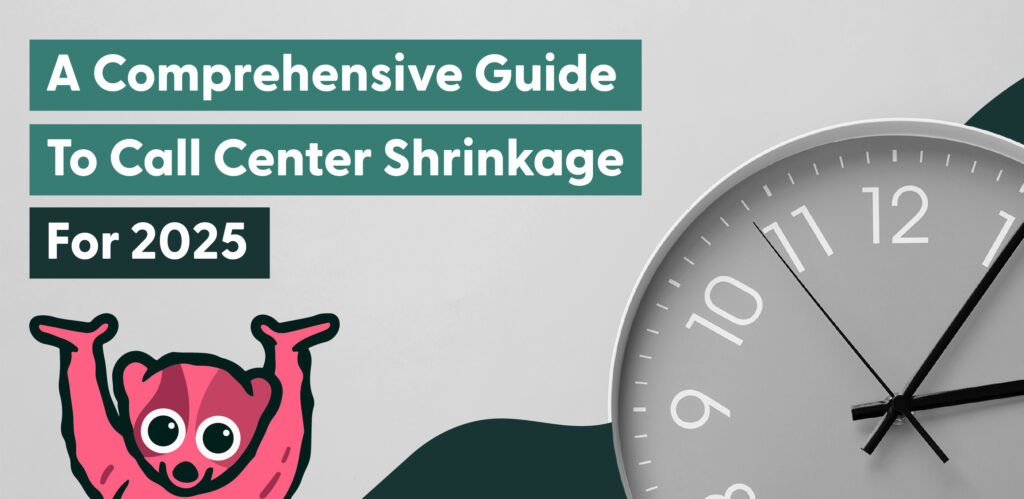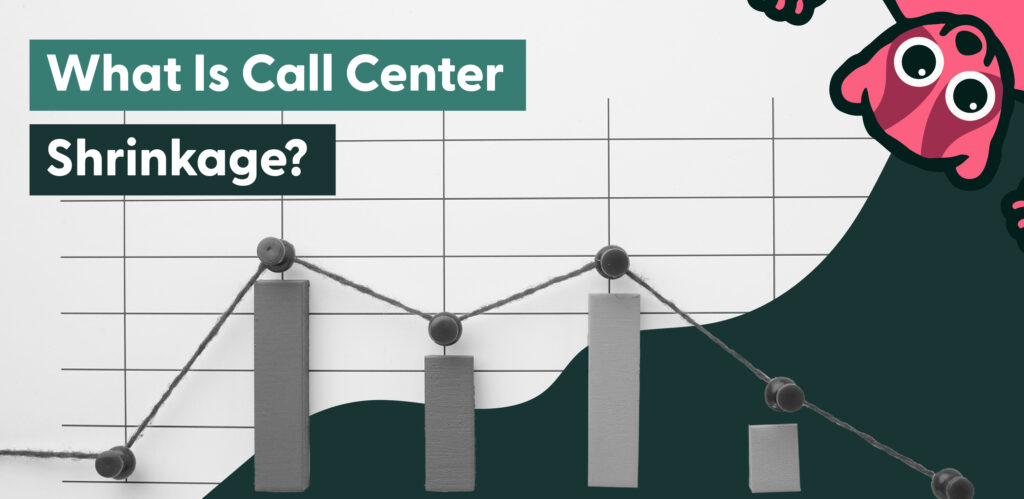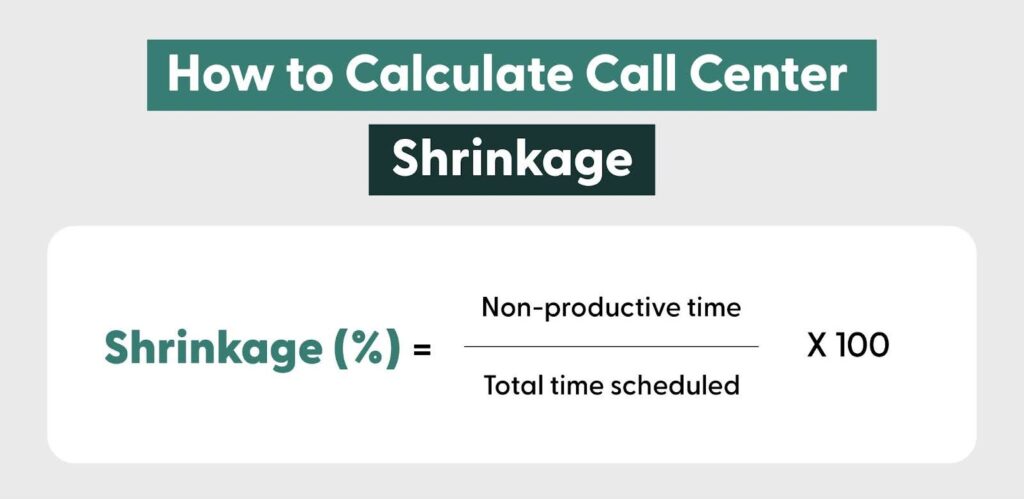
When customers have to wait a long time to reach call center agents, they become frustrated and harder to deal with. In fact, nearly 60% of customers feel that long holds and wait times are the most frustrating parts of a customer service experience.
Additionally, 62% of customers would prefer to “hand out parking tickets” than wait in an automated phone queue for service! Although this may make you chuckle, it’s a real problem in customer service.
Having a high call center shrinkage rate means your customers wait longer, your employees are less satisfied, and your operating costs increase.
In this article, we’ll unpack what contact center shrinkage is and 11 strategies to help you reduce it.
What Is Call Center Shrinkage?

Call center shrinkage refers to the difference between the total time agents spend productively handling customer interactions versus how much time they are paid to work.
This includes the time lost due to various factors that prevent agents from being available to handle calls, chats, or other customer service tasks.
Shrinkage is typically expressed as a percentage and is a critical metric in workforce management and efficiency in the call center industry.
Call center shrinkage is the opposite of occupancy rate, which is the percentage of time agents are on active calls with customers.
According to industry standards, a good call center shrinkage rate is between 25% and 35%. Many businesses consider the typical acceptable range to be around 30% to 35%.
The Two Types of Call Center Shrinkage
Call center shrinkage generally falls into two different categories. Let’s unpack each:
Internal shrinkage
These are the activities that occur within your call center during scheduled working hours but that don’t involve direct customer interaction. Examples include:
➡️ Team meetings: Regular or ad hoc meetings that take agents off the phone.
➡️ Training sessions: Scheduled or impromptu training to improve agent skills.
➡️ Coaching: One-on-one feedback or performance improvement sessions.
➡️ System downtime: Periods when technology issues prevent agents from working.
➡️ Breaks: Scheduled breaks for lunch or coffee and unscheduled breaks.
External shrinkage
These factors originate outside your call center and include:
➡️ Sick leave: Absences due to health reasons.
➡️ Vacation days: Planned time off for agents.
➡️ Holidays: Time off for national holidays.
➡️ Personal emergencies: Unexpected absences due to personal issues.
Like what you’re reading? Get this, and all the latest Loris news and product updates, delivered to you in our newsletter.
Why Does Call Center Shrinkage Matter?

There are several reasons why addressing shrinkage in your call center is important:
📞 Impact on service levels and customer satisfaction
When a significant portion of scheduled agent time is lost, fewer agents are available to handle incoming calls, chats, and emails.
This can increase wait times, first-call resolution rates (FCRs), and abandonment rates. In fact, over 60% of customers will hang up after waiting two minutes or less for an agent.
📞 Financial implications
High shrinkage can lead to inflated operational costs. When fewer agents are available than planned, you may need to overstaff to compensate for the loss of productivity, which increases labor expenses.
Alternatively, understaffing due to unmanaged shrinkage can result in missed revenue opportunities, especially in sales-focused or upselling environments.
📞 Workforce planning and optimization
Without accurate shrinkage data, workforce plans may fall short, leading to inefficiencies such as under-utilized resources or overwhelmed agents during peak periods.
📞 Agent productivity and morale
High shrinkage doesn’t only affect your customers; it also impacts the morale of your call center workforce.
When fewer agents are available to answer incoming interactions, the remaining staff must carry a heavier workload. This often leading to stress and reduced job satisfaction.
This is important because 58% of leaders say that more satisfied agents stay with companies longer and provide a better customer experience.
Organizations with high job satisfaction rates see 31% more productivity and 37% higher sales
Why Does Call Center Shrinkage Matter?
You can use the call center shrinkage calculation formula below to determine your shrinkage rate:

11 Strategies to Help You Reduce Call Center Shrinkage
Now that you know what call center shrinkage is and why it is important, let’s unpack some valuable strategies to help you reduce it:
1. Accurate forecasting and scheduling
Effective workforce management starts with accurate forecasting and scheduling. You can predict how many agents you need at any given time by analyzing historical data on call volume, peak periods, and shrinkage patterns.
Dynamic scheduling is also effective, allowing you to adjust shifts in response to real-time changes and demand.
For example, breaks and training sessions can be scheduled during low-traffic periods to avoid disrupting peak service hours.
2. Implementing flexible break and shift policies
Rigid schedules can lead to unplanned absences and lower employee morale, contributing to external shrinkage. The estimated loss of productivity due to absences is almost 40%.
Implementing flexible break and shift policies allows agents to manage their time more effectively while meeting their personal needs.
In fact, 83% of workers say flexible hours are a top factor in workplace satisfaction.
An example is allowing agents to take micro-breaks during low call volume or offering split shifts, which can help balance workloads and reduce burnout.
3. Leveraging technology to minimize downtime
System downtime significantly contributes to internal shrinkage, often caused by inefficient technology.
The average amount of downtime call centers experience each year is around 8.76 hours.
Investing in reliable hardware and software solutions reduces the risk of technical disruptions. Regular maintenance, updates, and proactive monitoring of systems also ensure smooth operations.
4. Optimizing training and coaching
Training and coaching are essential for agent development, but they can contribute to internal shrinkage if you don’t manage this effectively.
To minimize their impact on productivity, you can:
⏰ Schedule training during non-peak hours.
⏰ Implement e-learning platforms that agents can access at their convenience.
⏰ Incorporate training into regular work schedules without pulling agents off the floor for extended periods.
New research indicates that optimizing agent training time can significantly reduce shrinkage and help agents remain well-prepared for customer interactions.
5. Enhancing employee engagement
Employee disengagement and dissatisfaction are major drivers of unplanned absences and external shrinkage.
Disengaged employees cost organizations between $450 and $550 billion annually. On the other hand, engaged employees take 57% fewer sick days.
A positive workplace culture, clear communication, and recognition of employee contributions can boost morale and reduce absenteeism.
High job satisfaction is linked with a 27% reduction in absenteeism, and 69% of employees would be more motivated to work harder if they believed their efforts were acknowledged and recognized.
One survey found that an engaged workforce can increase company profits by as much as 23%.
6. Using real-time monitoring and analytics
Real-time monitoring tools provide you with immediate visibility into agent activity and adherence to schedules.
You can quickly identify and address shrinkage by tracking key performance indicators (KPIs) such as call handling time, break durations, and unplanned absences.
Analytics tools can highlight trends and patterns in shrinkage, enabling you to implement long-term solutions.
For example, if a particular type of call leads to longer handling times, targeted training can be introduced to reduce the length of these calls.
💡 Identify the Calls that Lead to Long Handling Times
As much as 40% of call volume is unnecessary or avoidable. Loris is a conversation intelligence platform that can help you identify the calls that take the longest to resolve and the root causes of these interactions.
This enables you to proactively resolve these issues before they result in high call volumes and more pressure on agents.
One company implemented real-time monitoring and performance incentives to address call shrinkage. As a result of these strategies, the business saw a 10% reduction in shrinkage and a 25% increase in agent productivity.
7. Creating a comprehensive attendance policy
A well-defined attendance policy for your call center sets clear expectations for agents and ensures consistent handling of unplanned absences.
Your policy should include:
📄 Guidelines for requesting time off.
📄 Consequences for repeated unexcused absences.
📄 Incentives for good attendance.
However, open communication about your policy is important as it ensures agents understand its purpose and feel supported rather than penalized.
8. Cross-training agents
Cross-training agents to handle multiple types of customer interactions, such as calls, emails, and live chats, increases flexibility and reduces the impact of absences.
If one team is understaffed, agents from another team can step in to fill the gap without compromising on service quality.
Over 70% of workers say that job variety and the ability to learn new skills make their work more satisfying, which is another reason why cross-training your agents is essential.
This approach also improves call center efficiency by enabling agents to adapt to changing customer demands and reduces the need for overstaffing during peak periods.
9. Minimizing administrative tasks
Agents often lose productive time to administrative tasks such as logging calls, upating records, or writing after-call summaries. In fact, in some call centers, agents can spend an average of 45 minutes of every hour on after-call work.
💡 How to Reduce After-Call Work
Loris reduces the amount of administrative and after-call work agents must do by automatically tagging and categorizing calls using Contact Drivers. These are the primary reasons or topics that prompt customers to call you.
Additionally, our platform uses artificial intelligence (AI) to generate automatic after-call summaries, reducing the amount of admin your agents have to deal with.
10. Addressing health and wellness
As mentioned earlier, a significant portion of external shrinkage is caused by illness and stress-related absences. Focusing on promoting employee health and wellness can mitigate this.
Consider implementing:
👉 Ergonomic workstations to reduce physical strain.
👉 Wellness programs focused on mental health and stress management.
👉 Access to healthcare benefits and counseling services.
Encouraging agents to take regular breaks, maintain work-life balance, and avoid overwork can also help to reduce health-related absenteeism.
Multinational company Johnson & Johnson estimates that their employee wellness program has saved the organization $250 million in healthcare costs. Their return on investment (ROI) in wellness programs is $2.71 for every dollar spent.
11. Regularly reviewing and adjusting strategies
Call center shrinkage management is not a one-time effort but an ongoing process. Regularly reviewing shrinkage data and evaluating the effectiveness of implemented strategies ensures continuous improvement.
You should remain adaptable and open to feedback, making adjustments as needed to align with changing business goals and operational challenges.
Mistakes to Avoid When Aiming to Reduce Call Center Shrinkage

While reducing call center shrinkage is essential, managers sometimes make counterproductive decisions. This can lead to consequences like increased absenteeism, lower morale, and poor customer satisfaction.
To implement effective strategies, it’s important to avoid these common mistakes:
👎 Overlooking the root causes of shrinkage: Shrinkage is often a symptom of larger issues, such as low employee engagement. Simply mandating stricter attendance or reducing break times won’t resolve the underlying reasons why agents are unavailable.
👎 Focusing only on punitive measures: Avoid reducing shrinkage by implementing harsh penalties for absences, tardiness, or non-adherence to schedules. While accountability is necessary, an overly punitive approach can create resentment, reduce morale, and worsen absenteeism.
👎 Poor scheduling practices: Inadequate scheduling can inadvertently increase shrinkage. If you fail to account for expected shrinkage—such as breaks, training sessions, or personal time—workforce plans fall short. This creates a stressful environment for available agents.
👎 Failing to provide adequate support for agents: Call center managers may assume that reducing shrinkage is solely the responsibility of agents, but failing to provide proper support can undermine these efforts. Agents who feel overwhelmed, unsupported, or ill-equipped to handle tasks may struggle with burnout. This can increase absenteeism.
👎 Not communicating goals and expectations clearly: A lack of clear communication about shrinkage goals and expectations can create confusion and resistance among agents. If they don’t understand why shrinkage is being monitored or how it impacts the business, they are less likely to comply with efforts to reduce it.
Let Loris Help You Reduce Call Center Shrinkage
Addressing call center shrinkage can help you deliver a better customer experience, lower operational costs, and boost employee morale.
With Loris, your agents have more time to be on active calls because our platform reduces the amount of excess admin they have to do, lowering shrinkage.
Our platform also helps you identify the root causes behind time-consuming interactions so that you can reduce your incoming call volumes, freeing up agents to work on more complex inquiries and having more time to focus on resolving issues.
This can lead to better employee satisfaction. This can also result in a reduction in absenteeism and shrinkage.
Speak to a Loris expert today to find out how our AI-powered platform can help you reduce call center shrinkage and better serve your customers.
